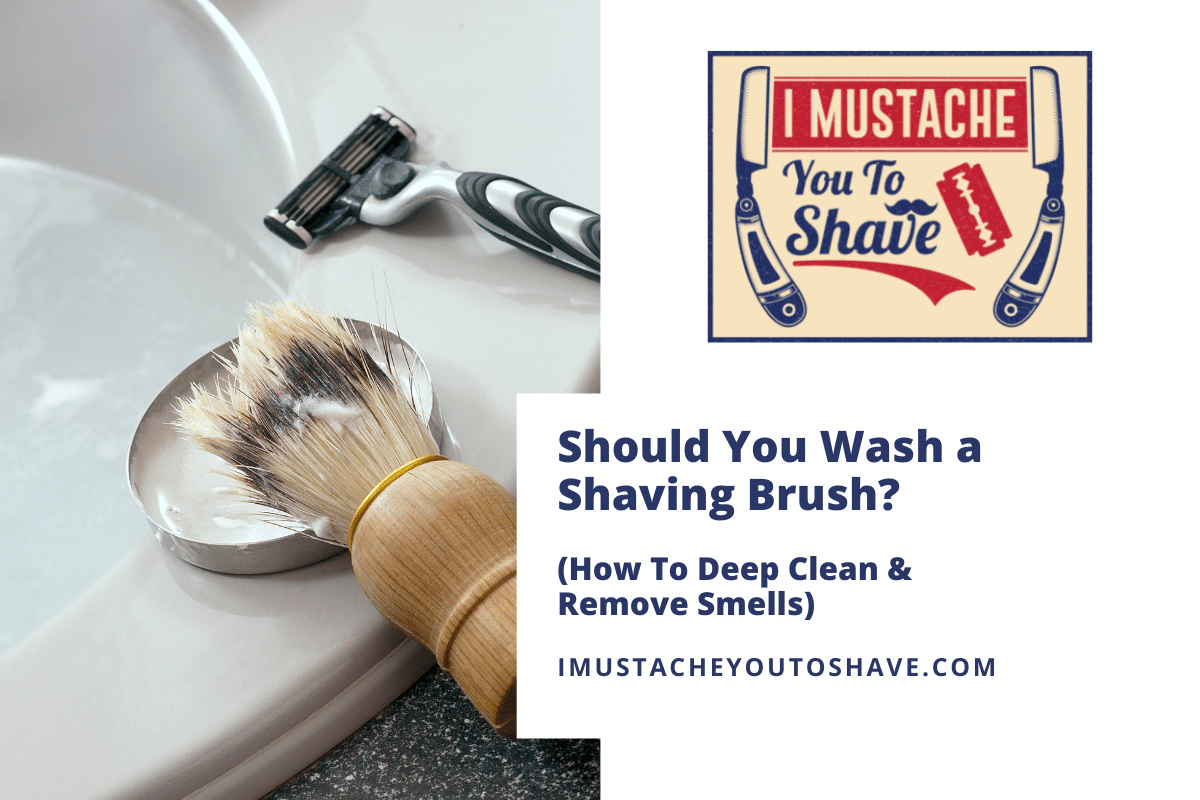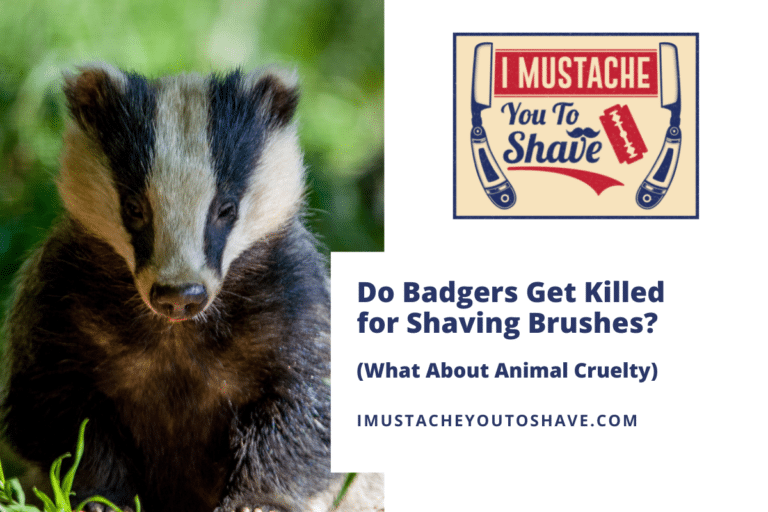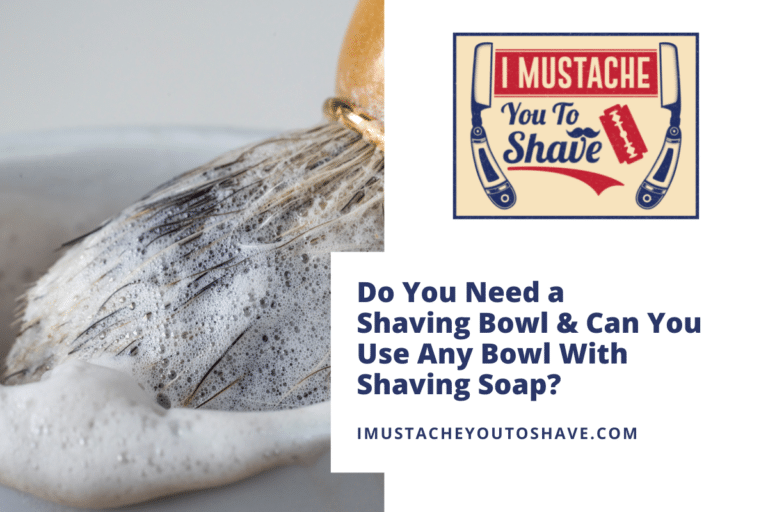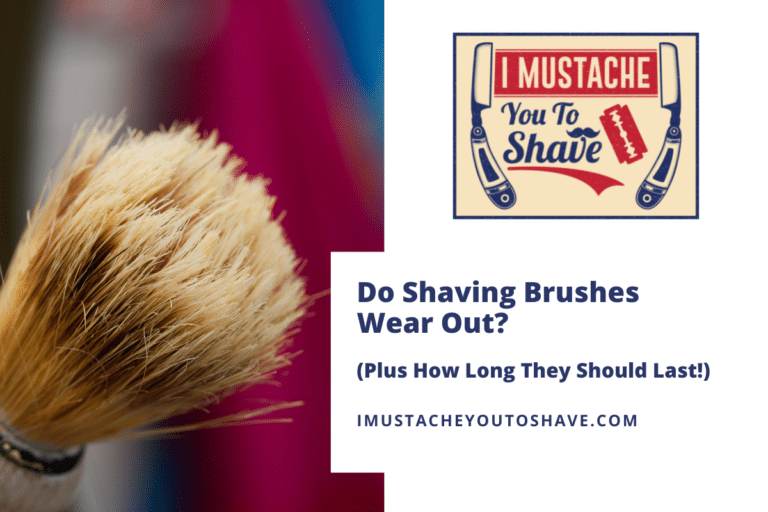Should You Wash a Shaving Brush? (How To Deep Clean & Remove Smells)
A shaving brush is a key tool in a man’s grooming arsenal. There’s no substitution for the creamy lather a brush can whip up. Since it’s used almost every day, how do you keep it clean and in prime condition? Does it require any special care?
Wash your shaving brush before the first use and periodically to keep it clean and remove any harmful bacteria and buildup. Rinse your brush thoroughly after each use to prolong its life and extend the time required between washes. Specific care will vary depending on the type of bristle, so refer to your brush’s care instructions at cleaning time.
If you want to learn how to keep your shaving brush clean and odor-free, read on!
Should you wash a shaving brush before using it for the first time?
Shaving brushes can come from a variety of sources. Many men prefer to buy their brushes new from retailers. Other men desire the retro experience of using a brush passed down from family members or found in antique stores. Whichever route you choose, a good wash is in order before you whip up that first creamy lather.
You should wash a new shaving brush before using it for the first time to get rid of any loose hairs and manufacturing debris. If using a vintage shaving brush, a deep clean wash is needed to remove build-up and bacteria.
New shaving brushes have gone through a lot before they are packaged up for sale. Production and packing both require handling by individuals or machines. Washing your shaving brush before you use it will wash away anything it’s picked up along the way.
If using a new, natural bristle brush, a slight smell is normal. Animal hair smells whether it’s still on the animal or not. While one wash won’t eliminate the smell completely, it should lessen the stench which will disappear after a few shaves and washes.
Antique shaving brushes have a story to tell. They’ve stood the test of time but may harbor some blood, sweat, and tears, not to mention microorganisms. A thorough cleaning can restore the bristles to their previous glory.
Fun (Disturbing) Fact: During World War I, American soldiers contracted anthrax from improperly disinfected horsehair shaving brushes. Horsehair was used as a substitute for the usual badger bristle brushes due to supply issues. The horses were infected with anthrax. Because of the war, the typical disinfection steps were skipped, thus passing on the infection.
Do you need to wash or clean your shaving brush?
Not only is a shaving brush essential to a perfect, frothy lather, but it also helps exfoliate the skin. The friction of the bristles removes dead skin cells. This is a positive for your skin but can be a foe to your brush. Over time, dead skin cells can accumulate among the bristles.
It is a good idea to wash and clean your shaving brush periodically to remove the accumulation of dead skin cells and soap residue. Clogged, weighed-down bristles don’t perform optimally.
On a daily basis, a simple rinse with warm water is sufficient maintenance. There’s no need for a wash session. A deep clean might be needed only once or twice a year. When performance lags, you know it’s time.
Should you rinse your shaving brush after each use?
You’re shaving with shaving soap so it automatically keeps your brush clean, right? Wrong! Shaving soaps don’t contain cleaning detergents like regular soap. Shaving soap or cream can get trapped down deep close to the knot reducing the utility of the brush.
Rinsing your shaving brush after each use removes shaving soap remnants that can build up over time. This quick, simple step will allow you to go longer between deep cleans.
Think about your bathroom sink. If you don’t rinse it out after your shave or brush your teeth, soap scum and dried toothpaste can accumulate making it unattractive and hard to clean. The same is true for your shaving brush.
How to deep clean a shaving brush
Just like with the hair on our head, the frequent addition of product can build up on natural bristles over time. This can reduce the effectiveness of the brush. Leftover shaving cream can get trapped close to the knot of the bristles. Spending a few minutes to deep clean your brush twice a year or so can restore it to peak effectiveness.
Common household products like vinegar or a clarifying shampoo can be used to deep clean a shaving brush. Apple cider or white vinegar can disinfect and strip the bristles of product build-up. A clarifying shampoo is made to eliminate the caked-on product. Pre-made brush cleaners are another deep cleaning option.
Vinegar cleans, sanitizes, cuts through dried-on messes, and helps neutralize smells. Your shaving brush can benefit from all of these actions. Put some vinegar in a spray bottle and massage into the bristles, or put some in a cup and soak the brush for a bit.
Clarifying shampoos are effective at reducing excess product build-up without stripping strands of their natural oils.
You can also buy a ready-made brush cleaner often used for makeup brushes. In essence, it’s a gentle cleanser that removes greasy dirt and debris.
How do you dry a shaving brush?
Moisture is a breeding ground for all kinds of grossness. To avoid bacteria growth, it’s best to let your brush dry completely between uses. If stored correctly, it should take less than 24 hours to dry. Natural bristles will take a little longer than synthetic bristles.
After cleaning, rinse the shaving brush with water, shake out the excess, and blot with a soft, dry cloth. Stand the brush up on its end to dry or hang in a brush holder. To speed up drying, place it in front of a fan or a sunny window.
Your brush needs sufficient air circulation to dry completely, so don’t close it up. Hang it on a shaving stand or stand it on its end with the bristles facing the sky. If you find it’s not completely dry by the next use, buy a backup brush and alternate between the two.
The drying question is also controversial. You’ll find one group that prefers the “dry on end” method claiming this allows the water to evaporate more quickly. Another group swears by the “hanging upside down” method claiming gravity helps it dry. Either drying style will accomplish the end goal – a dry shaving brush.
How do you take care of a badger hair shaving brush?
Badger bristle shaving brushes are a hot commodity today. Internet searches for badger brushes generate over 1.7 billion more hits now than twenty years ago. Their popularity is due to the bristle’s unique ability to hold water. This attribute is useful when it comes to working up a shaving lather that lasts through multiple passes.
Keeping your badger shaving brush in excellent condition takes some special care:
- Rinse daily – To keep the build-up to a minimum, rinse your brush with water after every shave.
- Deep clean when needed – If you notice your brush isn’t creating its usual lather, it’s probably time for a deep clean. Over time, shaving soap residue can coat natural bristles weighing them down. Using vinegar or a clarifying shampoo when you notice a difference can cut through caked-on strands.
- Hydrate bristles – Animal hair bristles can dry out and become brittle if not given some moisture. Massaging in a gentle conditioner before the final rinse can add needed hydration.
- Dry completely – To avoid the bacteria that thrive in a wet environment, dry your brush completely between shaves.
- Store properly – Your natural bristles need air. Don’t throw your brush into a shaving bag or drawer for long-term storage. Stand it up on its end on the counter, or buy a shaving brush stand and hang it.
Now let’s take a look at how to take care of a synthetic shaving brush.
How do you take care of a synthetic shaving brush?
Synthetic shaving brushes are great choices for anyone seeking vegan options. The price points are usually lower and the man-made bristles tend to dry quicker.
Synthetic bristles are typically made from Nylon or Taklon fibers. These fibers are uniform, unlike natural hair. Because of this uniformity, shaving soap residue and dead skin cells slide off instead of clinging to the surface eliminating the need for deep cleaning. However, if you drop your synthetic brush into the toilet, a deep clean is probably in order.
Here’s how to keep your synthetic shaving brush in top shape:
- Rinse daily – To ensure the brush is completely clean, rinse your brush with water after every shave.
- Dry completely – To avoid the bacteria that thrive in a wet environment, allow your brush to dry completely between shaves.
- Store properly – Synthetic bristles do not need as much care as natural bristles, but you should still store the brush carefully in order to avoid damaging the bristles or promoting the growth of bacteria. Stand it up on its end on the counter, or buy a shaving brush stand and hang it.
Since product buildup isn’t a problem with synthetic bristles, deep cleaning isn’t usually necessary unless you’ve dropped the brush or it’s been exposed to germs.
How do you take care of a horsehair shaving brush?
Did you know horse hair is very similar to human hair? In fact, many wig makers use horsehair to make wigs since it closely mimics human hair. The biggest difference is the hair’s diameter. Horsehair is 50% larger in diameter.
Since horsehair is another natural fiber, the care of your shaving brush is similar to that of a badger brush:
- Rinse well – To keep the build-up to a minimum, rinse your brush with water after every shave.
- Hydrate bristles – Like other animal hair bristles, horsehair can dry out and become brittle if not given some moisture. Massaging in a gentle conditioner before the final rinse can add needed hydration.
- Dry completely – To avoid the bacteria that thrive in a wet environment, dry your brush completely between shaves.
- Comb gently – Horsehair tangles more easily than other bristle options (including the natural ones). Using the coarse end of a grooming comb on the dry bristles will gently loosen any tangles.
- Store properly – Natural bristle shaving brushes require airflow. Don’t throw your brush into a shaving bag or drawer for long-term storage. Stand it up on its end on the counter, or buy a shaving brush stand and hang it.
- Deep clean when needed – If you notice your brush isn’t creating its usual lather, it’s probably time for a deep clean.
Have you ever heard of the shampoo and conditioner brand Mane ‘n Tail? This brand was originally birthed on a family horse farm in rural New Jersey. The product was formulated to clean and condition the manes and tails of show horses. These are the perfect products to keep your horsehair brush clean and hydrated.
How to store a shaving brush between shaves
Many shaving brushes rival a work of art. Ornate handles. Ombre hair variations. They should be stored for everyone to see.
Shaving brushes should be stored in a well-circulated, humidity-free environment when possible. This is especially important for natural hair brushes to lessen the chance of bacterial growth. They can be hung in a brush stand or stood on their end between shaves.
If your bathroom stays extra humid, store your brush in a drier environment when not in use.
How long does a shave brush last?
If you’ve ever strolled the aisles of an antique shop, you’ve likely seen some brushes dating back decades. It’s not unusual for ancestors to pass down shaving brushes. While many are still functional, they often end up as conversation pieces in a display case.
If properly cared for, shaving brushes can last for a very long time. Handles are often made of sturdy materials like wood, stone, or metal that stand the test of time. The hair knot is held into place with glue so it can break down after years of use. However, well-maintained brushes can have a useful life for generations.
Shaving aficionados often break out vintage brushes, razors, and mugs and relive the good old days in front of the shaving mirror. Shave enthusiast message boards boast a monthly “Vintage Shave” thread to photograph and describe the experience of using antique implements. eBay offers pages of old shaving brushes that are used but in excellent condition. Many shavers will argue that new isn’t necessarily better.





